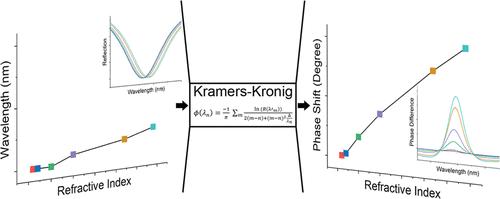Kramers-Kronig相位提取增强表面等离子体共振传感
IF 6.7
1区 化学
Q1 CHEMISTRY, ANALYTICAL
引用次数: 0
摘要
本文介绍了一种利用Kramers-Kronig (K-K)关系从反射光谱中提取相位来增强表面等离子体共振(SPR)传感的新方法。通过应用K-K关系,实现了3400°/RIU的相移灵敏度,将SPR检测限提高到9 × 10-6 RIU,比传统的SPR峰移测定方法灵敏度提高了4倍。这一进步能够更精确地检测水溶液中的折射率变化,使其具有生物传感和环境监测光谱仪的价值。本文章由计算机程序翻译,如有差异,请以英文原文为准。

Enhanced Surface Plasmon Resonance Sensing via Kramers–Kronig Phase Extraction
This study introduces a novel approach to enhance surface plasmon resonance (SPR) sensing using Kramers–Kronig (K–K) relations for phase extraction from reflection spectra. By applying the K–K relations, a phase shift sensitivity of 3400°/RIU is achieved improving SPR detection limits to 9 × 10–6 RIU, which is four times more sensitive than conventional methods for determining SPR peak shifts. This advancement enables more precise detection of refractive index changes in aqueous solutions, making it valuable for biosensing and environmental monitoring with spectrometers.
求助全文
通过发布文献求助,成功后即可免费获取论文全文。
去求助
来源期刊

Analytical Chemistry
化学-分析化学
CiteScore
12.10
自引率
12.20%
发文量
1949
审稿时长
1.4 months
期刊介绍:
Analytical Chemistry, a peer-reviewed research journal, focuses on disseminating new and original knowledge across all branches of analytical chemistry. Fundamental articles may explore general principles of chemical measurement science and need not directly address existing or potential analytical methodology. They can be entirely theoretical or report experimental results. Contributions may cover various phases of analytical operations, including sampling, bioanalysis, electrochemistry, mass spectrometry, microscale and nanoscale systems, environmental analysis, separations, spectroscopy, chemical reactions and selectivity, instrumentation, imaging, surface analysis, and data processing. Papers discussing known analytical methods should present a significant, original application of the method, a notable improvement, or results on an important analyte.
 求助内容:
求助内容: 应助结果提醒方式:
应助结果提醒方式:


